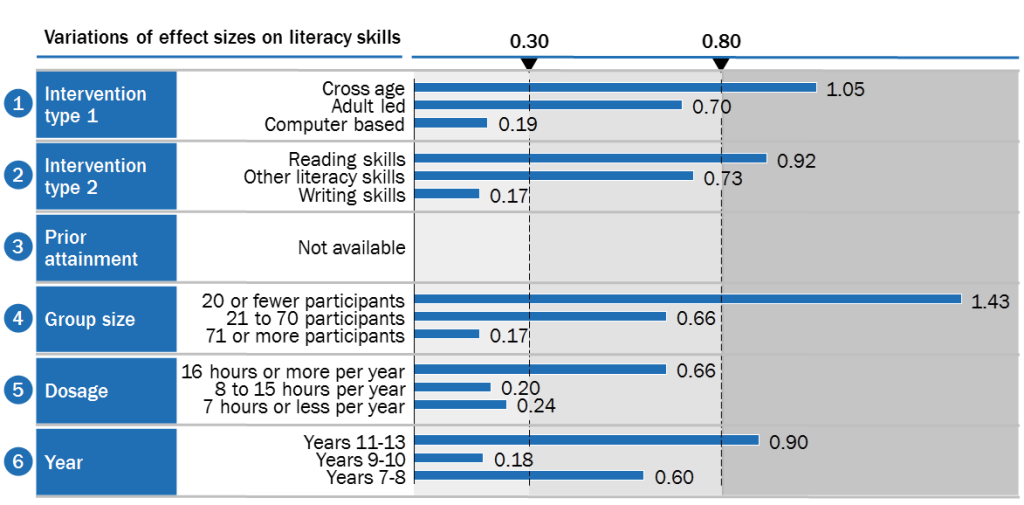Around 60 per cent of pupils achieve good marks in their GCSE exams, but if they come from a worse-off family the percentage comes down to 30. You may think that the solution is to give them more teaching hours in smaller groups. Not that easy.
At Aldaba, we looked at ten of the best pieces of research on after-school tutoring in the world. We found some useful lessons for teachers, policy makers, and school investors.
Longer learning hours, such as tutoring, in addition to standard school hours, have a small impact on literacy and numeracy skills
However, the impact varies depending on the type of intervention and the type of pupil. The chart below provides details on literacy. Bars stretching into the darker grey areas are for interventions whose impacts are stronger and more likely to happen if you try them for the first time.
For example, the impact of literacy tutoring in years 11 to 13 is greater than in earlier years.
We say that longer learning hours have a small impact because if we averaged out all the types of interventions and pupils included in the publication to which the chart refers we would obtain 0.26 on an impact scale that goes from 0 to 1.
Tutoring has a larger impact on literacy for those groups that are smaller than 20 tutees
It is a case of the more pupils, the lower the results, but note we only found this type of evidence in the case of literacy.
Tutoring has a larger impact on both literacy and numeracy if the tutor is certified or if there is an element of peer tutoring
It is no secret to anyone that the person leading the classroom makes a difference. If this person has been formally trained to run after-school tutoring, the chances are the results will be better.
The research we looked at also showed that providing students with a sense of responsibility helps a lot, for example by allowing them to tutor other pupils.
While none of these findings are magic bullets in themselves, they do provide a reference for those interested in designing interventions. The design features highlighted above may be combined in single interventions.
Worse-off families, low prior attainment
The research we looked at does not support the idea that after-school tutoring works better for these two groups. We saw mixed results.
For example, the 2014 publication by Kidron found a small impact on the attainment of pupils from worse-off families, but a moderate one on those who had had low academic achievement in the past.
Our research was part of a collaboration with Impetus-PEF. It built on ten meta-analyses which included 125 types of interventions, and 270 types of outcomes relevant to after-school tutoring. Read our report
The chart is based on Jun 2010, ‘Tutoring adolescents in literacy’. The title of the Kidron 2014 publication is ‘The effects of increased learning time on student academic and non academic outcomes’.
If you have taken the time to read all the way to this final line, please also make the extra effort to leave a comment. We would like to know your opinion.


